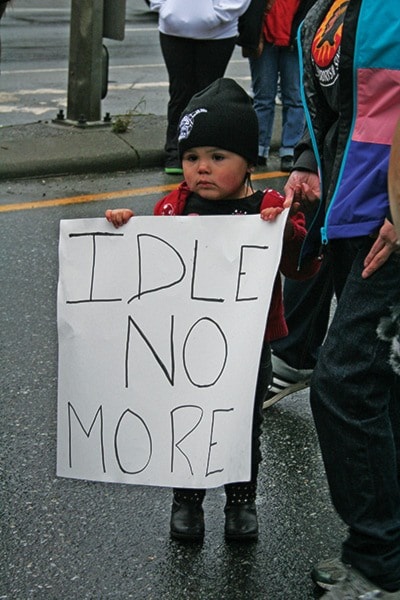Drums and voices rang out loud and clear on a cool Monday afternoon, as hundreds of people gathered just outside Ladysmith to lend their support to the Idle No More movement.
Idle No More means many things to Tim Harris, a Stz’uminus First Nation councillor and school principal.
Harris organized a mid-Island Idle No More demonstration Dec. 31 at the Husky Gas Station just north of Ladysmith with help from his sister, Stephanie Harris, and his cousin, Gina-Mae Harris.
About 300 people took part in the demonstration, many drumming and waving signs. They stopped traffic on the Trans-Canada Highway for a short period of time but mostly kept off the highway.
“I would have to say when I think of Idle No More, it kind of brought it all together,” said Harris. “It spoke a thousand words to me.”
Harris says, first of all, the demonstration supported Attawapiskat Chief Theresa Spence, who has been on a hunger strike on Victoria Island in the Ottawa River since Dec. 11. Spence vowed not to eat solid food until Prime Minister Stephen Harper would meet with her. Harper has set a meeting with First Nations leaders for Jan. 11, and Spence is expected to take part in the meeting.
Another aspect of Idle No More is killing Bill C-45, an omnibus budget bill that Harris says is “really tough” on the environment.
Harris says the main concern with Bill C-45 is the legislation regarding waterways and the environment.
“It basically puts it on a silver platter for pipelines to go through First Nations territories,” he said. “The other big thing is the lack of consultation within this.”
For Harris, one of the key aspects of the movement is standing together — and not just as First Nations, but as Canadians.
“It’s also in regards to solidarity and coming together and also stepping up,” he said. “For me, solidarity is not just First Nations coming together — it’s everyone. It’s all of us who use the land and care about the land.”
Education and awareness are important pieces of the puzzle for Harris.
“It’s saying ‘no, we’re not going to stand still and take this anymore,’” he said. “People need to understand we’re not just there for free handouts. We’re not just on reservations collecting free money. Idle No More is also about educating the public about what First Nations have gone through. It’s been a tough road for us.”
Harris emphasized that the Idle No More demonstrations that have been taking place across the country have been peaceful.
“Nobody wants to get the general public upset,” he said. “People have to work. We’re thinking of the working people, and we don’t want to shut things down. We don’t have to go that far. It’s more about being peaceful, and we want the public to support us.”
Harris says it felt very good to see so many people come together on Dec. 31.
“We had a lot of non-native supporters, which made it special for me,” he said. “A lot of the non-natives there were thanking us for doing this and thanking us for letting them be there. For once in my life, I felt that solidarity. It’s a real good thing for us, coming together — and not for anything bad; it’s educating people. It was a real good feeling. I felt empowered a little bit.”
